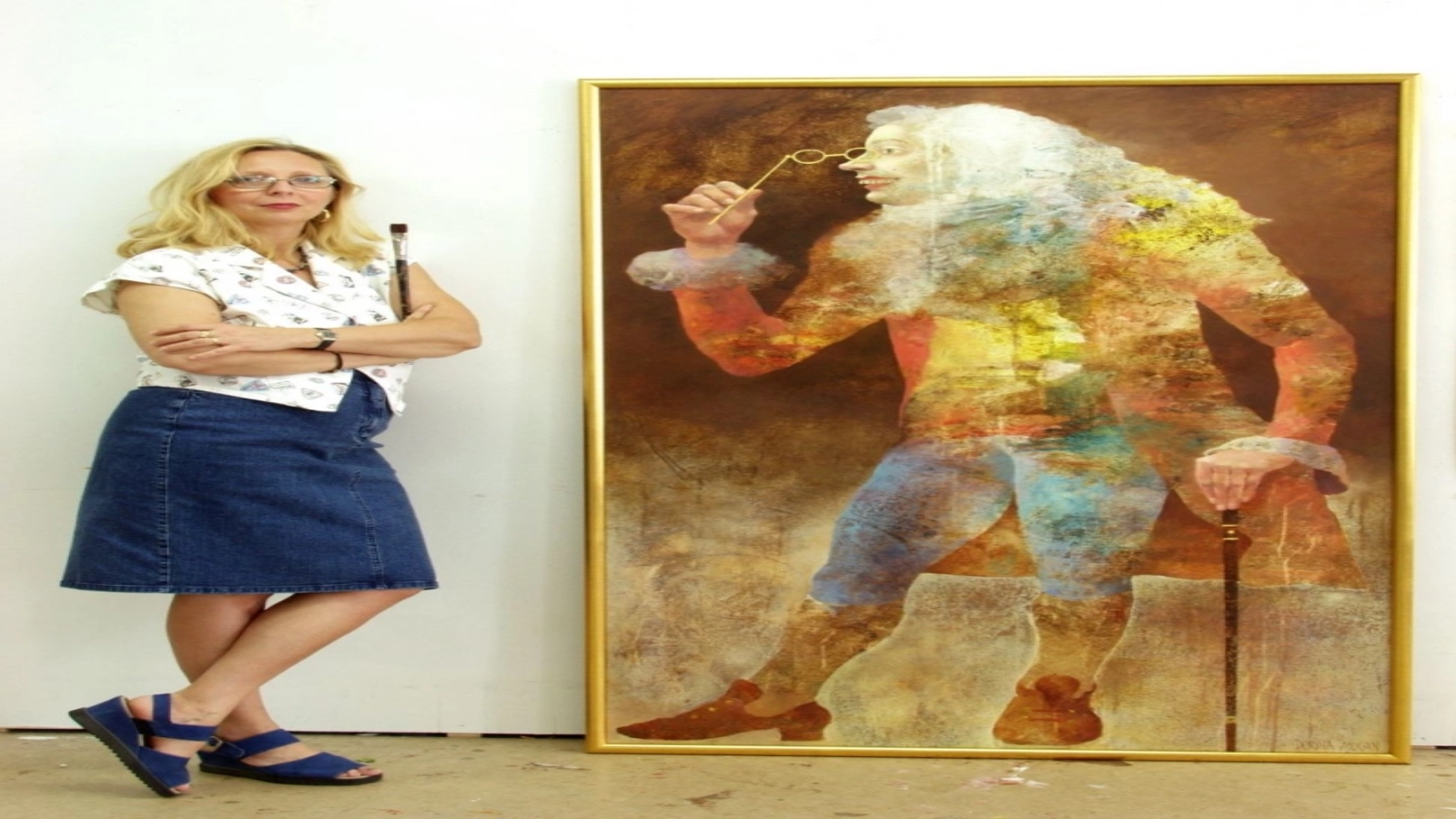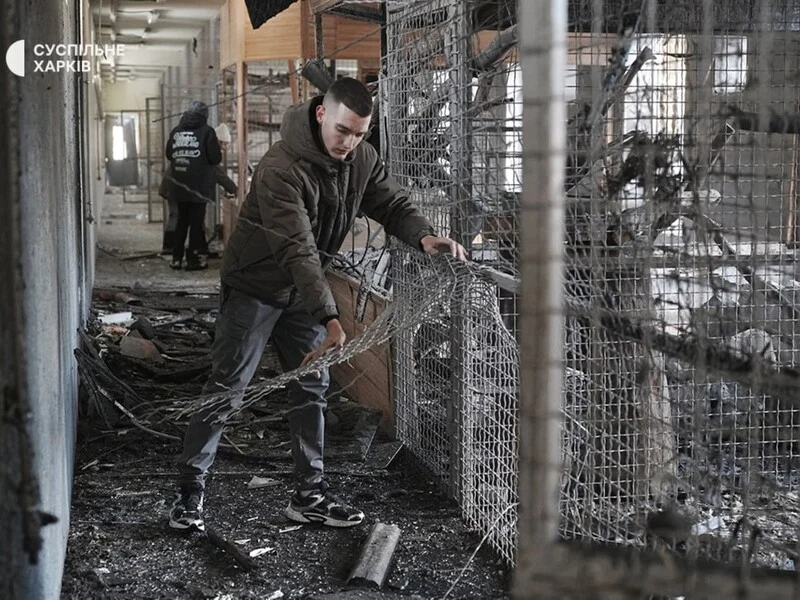She was born, grew up, studied and started her artistic career in Romania, but she has been living in Sweden for more than four decades, after the communist regime forced her to simply leave her native country.
Today, her paintings have reached dozens of countries, on several continents, and the royal families of Romania and Sweden are among those who bought her paintings. Far from her native country, Dorina Mocan always carried Romania in her soul, just as she always carries DOR in her name.
.jpg)
"I was born in the city of Targu Mures as the only child of my dear parents, Romulus and Rozalia. I lived in the center of the city, neighbours with a large amusement and relaxation park Lázár Ödön, located between the years 1950-1971 in the place of the theater square of today. During the summer there was a summer cinema there, right next to our house, over the fence, so to speak. Some of us, children were admitted free in the evening, if beforehand, that day, we helped clean between the cinema benches. I watched many films from the 60s together with the children of the neighbourhood. In the evenings we all sat on the first bench of the cinema, each with a large sandwich in hand, brought from home and made by my mother. After a while, I knew all the lines of the movie by heart. Before the movie started, the audience gathered in the park, at the entrance of the cinema, listening to the new music of the time, in the loudspeakers. My friend Edit and I liked to dance in front of the crowd, usually just the two of us. In the summer there was play, dancing and joy, but in the fall the serious work at school began. So I grew up in Targu Mures, a city with a rich cultural life and with the famous Palace of Culture, built at the beginning of the 20th century in Art Nouveau style. In my childhood, stepping into that wonderfully ornate building was like entering a fairy tale palace. That feeling, accompanied by the support and love of my parents, definitely fueled my growing interest in art," Dorina Mocan tells AGERPRES.
The artist's passion for painting was passed on to her from her father, but it is also related to the walls she drew with a pencil from an early age.

"My first encounter with art happened very early, because my father, an economist by profession, was an art lover and painted himself in his spare time. Among my first memories was being able to touch his painting tools and do what he was doing because I found it so captivating. I remember running around him once and accidentally spilling his palette and brushes on the floor. I started to cry. My father then picked me up and he put a brush in my hand to comfort me. Since then, that brush has always been with me. From a very young age I was obsessed with the magic of the image and my parents had to cover the walls of our house with protective paper because I drew everywhere, as soon as I found a pencil. Finally, I received a weekly amount of money, or rather a penny, to buy my drawing pads. Every week I filled at least one notebook. It was so thrilling to visit the tobacco shop in the neighborhood, where they sold everything, even sketchbooks. They were some of the happiest moments of my childhood," Dorina Mocan recalls.
The theoretical foundations of painting were to be laid at the children's art school at the Palace of Culture in her hometown, to be further studied at the Art High School and the Art Academy in Cluj.

"I had the happiness of being able to study art from the age of 10 in my hometown. In that Palace of Culture, next to the concert hall, the art museum, the library, the UAP gallery, there were also workshops of the art school for children, up to the high school level. I was 'discovered' in the 4th grade, during the visit of a so-called talent scout. I was then called to a competition, organized for children from all over the country. At that exam, held in the beautiful premises of the Palace, I was admitted to and later I took practical tests at different stages, following the Art High School, then the Cluj Art Academy,'' the artist says.
She remembers that she had good teachers during high school, "spiritual educators and brilliant artists".
"Their simple presence was very inspiring and beneficial. In my childhood, the artist was for me a person with a special aura, who sometimes appeared on the streets of the city as God himself. I felt a special respect for Nagy Pal, whose pedagogical method was to give students only the right hints to solve plastic problems by themselves, without, therefore, offering clear solutions and recipes. He was demanding, but when I succeeded he knew how to express his appreciation with sincere generosity. I also fondly remember the sculptor Izsak Marton, the director of the school. It was captivating to attend his sculpture lessons, smell the soft clay and observe his gift for teaching. My parents, worried, stopped him once on the street, right on the eve of high school graduation, when I was planning to enroll at the Academy of Arts. 'Was I talented enough? Did I have any chance of being admitted there?', they asked him. As is known, the competition was huge. Few places, and there were many applicants. Izsak Marton reassured them, giving them an encouraging answer. Only the following year, after I was admitted to higher education, I've found that out," the painter states.
Although the period of studies was followed by her affirmation as an artist, when everything seemed to be going very well, the communist regime simply forced her to leave her native country.
"After the four interesting and valuable years at the Academy of Arts in Cluj, I got a job as a teacher at the People's Art School in Sfantu Gheorghe. Thanks to the high grades in my graduation diploma, I was able to choose between several jobs in the country, places offered as part of the compulsory three-year distribution. Learning that there were some modern painting workshops at Sfantu Gheorghe, in the fall of 1977, I went there as a teacher. In addition, I also knew the Hungarian language, a very useful fact in a city where the majority of the population spoke Hungarian. I was lucky enough to rent the last free creative workshop available in the city, on the eighth floor of a tall building, with large windows and a perspective of several kilometers, where I could devote myself to my own creative activity, in addition to teaching work. It was a kind of liberation, the peace acquired after the years of hard work as a student, under the same roof, with other colleagues, far from the precious instructions of the teachers,'' she says.
That's when, in fact, the process of finding one's own style and identity, of self-examination, in the solitude between the high walls of the workshop, the sustained effort to become an artist began. Because, to be able to call yourself that, the twelve years of art and college studies were not enough, Dorina Mocan testifies.
"So, I started well, I had a good job, a nice workshop, my works were appreciated more and more, so I was quite satisfied. I was not thinking of leaving the country and, being alone with my parents, at first, it was almost unthinkable. But later I changed my mind - when my husband, a political refugee and fellow artist from his student years, was not granted the right to work because of his foreign citizenship. He was not even allowed to fill in for my teaching hours at school during my maternity leave in December 1979. To our disappointment, another colleague of mine, who already had a full-time teaching job, was allowed instead. at the same school. There were also other sad events, which followed each other quickly: the loss of the job, the workshop, our new apartment, in a word, the entire economic security. My world had completely collapsed. I gave up everything then, simply, and followed my husband to Sweden, in order to save the integrity of our little family," the painter says.
The highlights of her artistic activity include the exhibitions from the short period when she worked in Romania, but especially her international recognition, after leaving for Sweden.
"In Romania, at the end of the 70s, I had the opportunity to participate in annual group exhibitions together with local professional artists. They were municipal exhibitions, from where the state made purchases, regularly. I also exhibited in Bucharest, in Sala Dalles, in 1978 and 1979, where I participated with a large triptych, which I sold for an amount corresponding to my annual salary as a teacher. I had my first and only personal exhibition in the country in December 1979, in the premises of the UAP Gallery (Union of Visual Artists) from Sfantu Gheorghe," she remembers.
And the story of the artist continues with the revelations about her new life in Sweden.
"In my new country, Sweden, since my arrival in October 1981, I found my way gradually, because the transition is not at all easy when you do not know the language and feel that, for the time being, you do not naturally belong to society. But I didn't come empty-handed. I had my youth and the desire to do good. In addition, I had an artistic education, professional experience and the possibility of communication through the universal language of art. In Sweden, I exhibited since the first year, in the municipal exhibition hall in Upplands Vasby, my town, located north of Stockholm. I then had the satisfaction of selling two works: one of them to a private person, and the other to a public institution. Contacts with art associations followed, numerous and very active in a country where the support of civil organizations has a long tradition. Art associations in Sweden have had and have a great importance for the artistic life of the last decades. In 1983, after a rigorous selection, I managed to enter the Spring Salon organized annually by the Liljevalchs konsthall Art Gallery (in Stockholm), the most important juried salon in Sweden. It was a big competition, with thousands of candidates. I attended that salon six times during my first years in Sweden. It was a springboard in my career, because it has a lot of visitors, where I was able to make myself known to a large audience, establish many contacts and thus obtain new opportunities to exhibit,'' she said.
In the 90s, Dorina Mocan received many offers to exhibit in European countries, such as Denmark, Norway, Germany, England, Greece, Holland and Poland.

"I also received important commissions from international cruise lines, so that, since the end of the 90s, my paintings have been 'sailing' on several oceans of the world. Sometimes I get flattering reactions and requests to purchase my painting from people who liked my art displayed on board the boats they traveled with. In the early 2000s, I participated in the Shanghai art fair, which led to a fruitful, long-term collaboration with a Hong Kong gallery, Connoisseur Art Gallery. The owners of that gallery had a large international clientele and managed to place my works in various European countries, but also in the USA, South America, Australia and in Asian countries such as: China, Taiwan, South Korea, Singapore, Japan, Indonesia. Today, I am represented with my art in about 30 countries. The achievements of the early 2000s, when I managed to establish myself artistically in another culture and receive the confirmation of an international audience, gave me great professional satisfaction. The years of collaboration with galleries in Asia were also important because almost all of my production from those years was intended for intense collaboration, especially with the Connoisseur Art Gallery. In 2017, I was awarded in Denmark, at the prestigious international competition Portrait Now, open to artists from the Nordic countries. Several thousand applications were registered, of which only 70 works were accepted. The prize-winning painting is called Sara And Her Entourage/Sara si anturajul ei. Also, I am quite proud of the honorary mission I received from the municipality of Örebro, to portray the first woman as president of the Municipal Council. The painting is mounted in the large meeting hall of the City Hall," the painter mentions.
Among the themes addressed in Dorina Mocan's paintings are the twisted horns of the rams on the island of Gotland, in the Baltic Sea, which remind the artist of Miorita's ballad, but also the feminine beauty associated with her mother's face.
"Looking at my artistic production from the last decades, I find that certain moments, meetings, were decisive for the birth of a work and even for my artistic development. My long stays on the island of Gotland, in the Baltic Sea, from the mid-90s, introduced new elements into my art, a new kind of strength and energy, a greater joy and clarity. The encounter with the magical landscape of the coral island enriched my painting, which even today bears traces of these happy and inspiring journeys. For example, an important encounter was with the medieval architecture, flora and fauna - the island's birds, cats and rams, the twisted horns of whom fascinated me. My encounter with a flock of sheep on Gotland in the last rays of sunlight of the warm setting sun, was able to create an almost biblical experience for me. I felt transported. The sheep on a meadow, which rushed towards me unexpectedly, made me think of the Romania of my childhood, whose beautiful ballad, Miorita, talks precisely about a shepherd and his sheep. As a child, I won a national recitation contest with this ballad, the melancholy of which I carried with me throughout the years. The horn, a symbol of strength and masculinity, was borrowed by the girls in my paintings to strengthen them and challenge traditional gender roles, because strength is not usually equated with young girls,'' she says.
Dorina confesses that, since childhood, she was fascinated by the kindness and tenderness of her mother.
"Ever since childhood, I was fascinated and captivated by the kindness and tenderness of my mother's face, but also by her strength, by the beauty of my friends, and of all the women, girls or children I met over the years, on my way. Most of my works dealt with this subject, through which I felt close to my own feminine Self and always at home in my creative work. Inspiration usually begins in a moment of great amazement, curiosity and fascination with what I encounter, and this quality is important to preserve, not only because it is associated with the joy of life, but because my art is based there. It is of vital importance to stop before things with childlike delight, without rushing and thus missing the charm of the moment. A painting has its starting point, in the desire to share this encounter, this powerful experience, through the process of recreating and preserving this feeling throughout the creation, until the completion of the work. I understood a long time ago that art is closely related to life and the condition to create is to be constantly in love with life, with what you meet on your way, to be able to express all this magic, happiness and suffering of existence," Dorina Mocan says.
The recognition of the value of the artist born in Targu Mures also came from the Royal Family of Sweden, who appreciated her paintings and purchased a painting for Princess Viktoria, the future queen of Sweden.
"In the fall of 1998, the royal couple of Sweden visited my exhibition at a gallery in Stockholm. But that visit was preceded by three other meetings of their majesties with my art, in different exhibition contexts. The first was in 1996 when, as part of cultural exchanges between Sweden and Chile, I participated in an exhibition at Centro Cultural las Condes, Santiago de Chile, on the occasion of the Swedish royal couple's state visit to Chile. Fortunately, I met the royal couple again in the following years, in two different exhibition contexts and I got to talk with their majesties on both occasions when they stopped in front of my paintings. I was grateful that I had a discussion and a very positive response to what I presented on both occasions. Of course, I was happy when Queen Silvia and the First Lady of the Royal Court Louise Lyberg (senior adviser at the Bukowski auction house) visited my exhibition at the gallery in Stockholm. It also happened to be my birthday. All the paintings had been sold in the previous days, at the opening. When the Queen returned with the King a week later, it seemed embarrassing that we could offer nothing to their majesties. I proposed to present two new works in the spring of 1999. Said and done. And one of them, Scara din Ĺminne/The Ladder of Ĺminne, was purchased and offered as a birthday present to Princess Viktoria, the future queen of Sweden," the artist adds.

Another royal family, that of Romania, would be counted among those who appreciate the artistic work of Dorina Mocan, whose last exhibition was opened, recently, at the Romanian Cultural Center in Stockholm, on which occasion Her Majesty Margareta and Prince Radu admired the artist's paintings.
"The meeting with the Romanian royal couple at my exhibition at the Romanian Cultural Institute in Stockholm was fantastic from all points of view. Their majesties' visit, in the presence of ambassadors from different countries, high-ranking Swedish politicians, representatives of the Swedish Royal House and others distinguished guests, it has acquired a strong symbolic value for me, after four decades since I was forced to leave my country. I felt a sincere interest in my art on the part of their majesties, through the questions they asked and the way in which they stopped and reacted to some of my works. A few weeks later, the painting The Girl From Pompeii was purchased by the Romanian Royal couple and today it is in the Elisabeta Palace, to my delight. I feel great satisfaction that this the painting is in the land of my childhood and youth and that it was offered such a beautiful and distinguished place," the painter states.
After more than four decades spent away from her native country, Dorina Mocan believes that the time has come for her art to be known in Romania as well, through an exhibition.
"I think of the young woman in me, who bravely set out on the road, in a foreign country, with a 17 kg suitcase in one hand and a small son of almost two years old in the other. I had many dreams - apart from a professional training and experience - in that baggage, which has become better and better filled over the years and the journeys of life. A return to the place from where I left would be like a celebration. My intention would be to open this suitcase of destiny and time and let's see what has been gathered, what lies inside. In the past decades, I have gone out into the world with my art to see where I stand in relation to other cultures. I received answers and the satisfaction that my art is loved and appreciated in the wider world. Recently, I received a nice feedback and I feel overwhelmed by the way in which a new Romanian public, the one at home, expresses its feelings towards my art. Maybe the time has come for the next step, maybe the biggest and most important of all, that of returning to my native lands. It remains to be seen if and when this can become a reality," the artist says.

"I even carry the word DOR/MISSING in my name, as long as I live. But when you have to leave a place, to integrate in another country, you have to feel at home in your new culture, without feeling longing for your native country, without constantly want to go back. I took my country, Romania, with me in my soul and my cultural legacy was somehow always present in my art. When I think of Romania, I see myself wandering alone and happy in nature, in my youth, with my drawing pad. There are other different memories, more or less beautiful, but this memory image is the dearest to me and supersedes all other memories. Through the light, the force of enthusiasm, its clarity and simplicity, it managed to survive the passage of time and geographical distances. I carried Romania with me all the time, in my Romanian name that I never wanted to change, and through my profession and cultural work, the country's name was mentioned in all contexts, both nationally and internationally. The first thing mentioned on the biography list of an artist is the place where he/she was born, the education. I am proud and have always told about my origins and the good start I had in my native country, where there were art schools for children since the 60s. I was thus lucky to be born and raised in Romania, a significant fact, which is an important part of me, just as my childhood and youth live strongly in me as long as I exist. Of course, it was not difficult for me to settle in Sweden, which gave me the opportunity to develop my career and made me feel at home in both cultures. But with my exhibitions at the Romanian Cultural Institute, I discovered a surprising new feeling, a special warmth in meeting my compatriots. Longing, memories returned and gave birth to thoughts and feelings that were almost taboo for four decades. But today, unlike in the past, I allow myself to feel. I don't forbid the bitter sweetness of longing. Even returning is allowed, even possible, in one way or another. We will see," concludes Dorina Mocan.
































Comentează